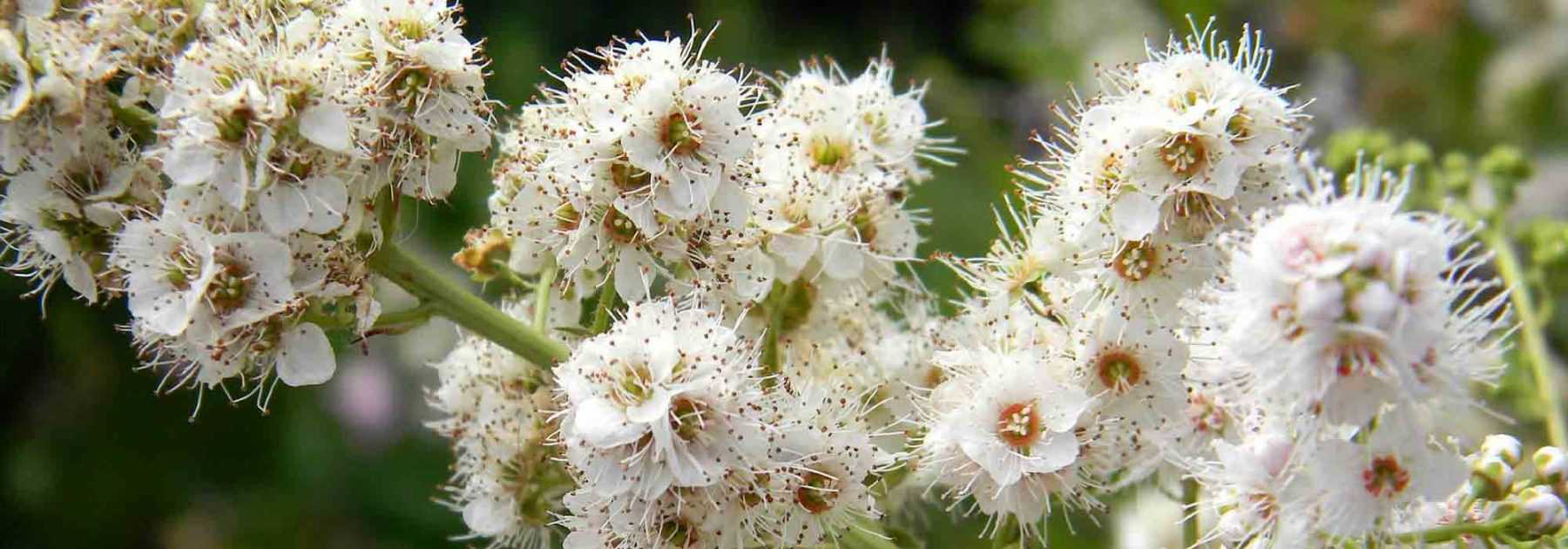
Spiraea, Spirea: Planting, Pruning and Care
Contents
Spirea in a Nutshell
- Spirea is a beautiful bushy shrub with spring or summer flowering
- Very easy to grow, it’s often one of the first shrubs planted by beginner gardeners
- Hardy, it adapts to all climates and soil types
- Undemanding, it finds its place in all gardens, from small to very large
- Perfect for informal hedges, flower beds, and for dwarf varieties, borders or even rock gardens
Our expert's word
The Spiraea is a vigorous, easy-to-grow shrub. It is prized for its abundant spring or summer flowering, its compact habit and its dense foliage, green or sometimes yellow in the case of the golden spiraea (Spiraea ‘Goldflame’).
From March to August, depending on the species, clusters of small flowers – pure white in Van Houtte’s spiraea and Spiraea arguta, pink in Spiraea billiardii – literally cover this light and graceful bush. And that’s not counting the cultivars of Japanese spiraea or Spiraea japonica, such as ‘Anthony Waterer’, undoubtedly the most widely grown of all Japanese spiraeas!
This is a very hardy shrub that can withstand almost anything and adapts to any climate and almost all growing conditions.
Hardy down to -20°C, Spiraea thrives in full sun or partial shade in any well-drained ordinary soil. With fairly rapid growth, it quickly forms beautiful, floriferous screens that are easy to prune.
Undemanding and versatile, this shrub has a place in every garden, whether for creating spiraea hedges or flowering borders, beds, rockeries or even terraces.
It’s a reliable shrub whose success is well-deserved, as it is easy to grow while being incredibly generous.
Description and botany
Botanical data
- Latin name Spiræa
- Family Rosaceae
- Common name Spirea
- Flowering from March until autumn depending on the species
- Height 0.30 to 3 m
- Exposure Sun, partial shade
- Soil type All types, well-drained
- Hardiness -20°C to -25°C
The Spiraea genus includes around 80 species of deciduous or semi-evergreen shrubs or small trees thriving in cool to occasionally moist areas, in ditches, rocky outcrops, scrubland, forest edges, stream banks or light woodland. Belonging to the Rosaceae family, spireas originate from temperate regions of Europe, Asia, America and Mexico.
The spirea genus is highly diverse. We distinguish spring-flowering spireas and summer-flowering spireas, some are ground-covering while others form beautiful shrubs, most bear typical umbel-shaped flowers while others produce spikes. The genus includes a multitude of species such as the Birchleaf Spirea (Spiraea betulifolia), Japanese Spirea (Spiræa japonica) with white or pink summer flowers, Spiraea billardii with pink summer spikes, Spiraea arguta and Spiraea van houttei with white spring blooms.
With moderate to fast growth, this graceful shrub with a bushy, upright and compact habit forms a dense clump, more or less rounded, ranging from 40 cm in height to easily 2 to 3 m tall, with a spread of 2.50 m for the largest varieties. Some like Spiraea x Vanhouttei have a fountain-like habit, with branches elegantly arching at the tips.
Spirea develops over the years into large, impenetrable thickets. Some species tend to spread and produce numerous suckers around the base.


From left to right: Spirea japonica ‘Little Princess’ – Spirea vanhouttei – Spirea japonica ‘Anthony Waterer’ – Spirea billardii.
The intensely luminous foliage forms a compact and attractive green backdrop in spring as well as autumn. The deciduous leaves, entire, slightly toothed, simple or grouped, emerge in spring on numerous fine, upright and often highly branched stems.
Measuring 1 to 12 cm long, they are oval to lanceolate or even diamond-shaped, some like the Birchleaf Spirea resemble those of dwarf birch.
Young shoots sometimes emerge copper-orange or reddish-brown and unfurl into leaves generally medium to dark green or bluish-green, sometimes greyish underneath. Some varieties (‘Tor Gold’, ‘Gold Fountain’) have golden or copper foliage, changing through the seasons, displaying all shades of orange, fiery red and purple from spring to autumn before falling.
The spring or summer flowering is spectacular and very abundant. From March to June or June to September, depending on the species, the shrub becomes entirely covered with a multitude of flowers in pure white, pale pink, bright pink to raspberry pink or deep red (Spiraea japonica Sparkling Champagne), which adorn the foliage for three weeks.
From a large bush of beautiful density emerge small cup-shaped flowers grouped in umbels along the previous year’s branches for spring-flowering spireas, in small flattened clusters (corymbs) 3 to 20 cm wide or in very dense spikes 10 to 20 cm long at the tips of the current year’s shoots for summer-flowering varieties.
The Spiraea prunifolia Plena stands out from others with its double, flaky flowers, while the Spiraea thunbergii ‘Fujino Pink’ is a delightful variety of Thunberg’s Spirea whose early spring flowering somewhat resembles that of an apple tree.
Long stamens protruding from the flowers often give these inflorescences a downy appearance, highly visited by butterflies, bees and bumblebees.
Spirea is one of the few shrubs that flowers in midsummer. This prolonged flowering often reblooms in late summer or early autumn for summer-flowering spireas. For some, the flowering is so massive that it gracefully bends the branches towards the ground.
The flowering is followed by fruits of little ornamental interest, but much appreciated by birds.
Spirea is easy to grow, in sun or partial shade for golden-leaved varieties, in any fresh, well-drained soil. Very hardy down to -20°C to -25°C, it grows well in all regions, provided conditions aren’t too arid.
For a rose family member, it’s exceptionally robust, resistant to diseases and pests.
It’s ideal for creating a countryside hedge or in shrub borders combined with perennials along pathways, or even as a standalone specimen in rockeries, or as ground cover for low-growing species. It also thrives in containers on terraces and balconies.
Considered a sacred plant by druids, since the Renaissance, Spirea has also been recognised for its healing and tonic properties.
Main species and varieties
Depending on the species, Spireas bloom either in spring (from March to June) or in summer (from June to September).
The Spiraea vanhouttei, also called Spiraea x vanhouttei, or Van Houtte’s Spirea with its small white flowers in May and June, can reach 2 metres in height and 2.5 m in width, and is the most well-known of all. With its cascading white blooms, it is frequently used by landscapers for greening large embankments or roadside plantings…
Alongside this classic variety, you’ll find the Spiraea x billardii with its pink flowers in July, the Spiraea betulifolia or Birchleaf Spirea, and the Spiraea japonica, which blooms in summer with pink or white flowers and has given rise to numerous cultivars (‘Firelight’, ‘Magic Carpet’) with light, golden, or even bronze foliage in autumn.
The modest size of Japanese Spirea (maximum 1 m in height) makes it ideal for small gardens.
Dwarf varieties (‘Nana’, ‘Little Princess’) can be used as ground cover, in miniature hedges, or even in pots.
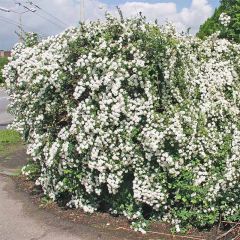
Spiraea x vanhouttei
- Flowering time May to July
- Height at maturity 2 m
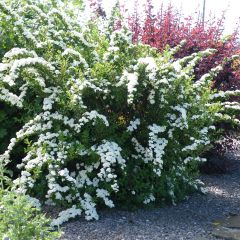
Spiraea nipponica Snowmound
- Flowering time May, June
- Height at maturity 2 m
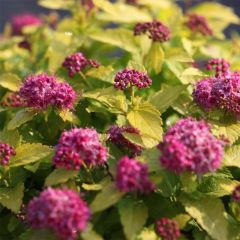
Spiraea japonica Double Play Gold
- Flowering time July to October
- Height at maturity 70 cm
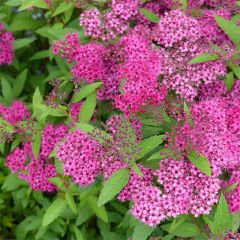
Spiraea japonica Anthony Waterer
- Flowering time July to October
- Height at maturity 1 m
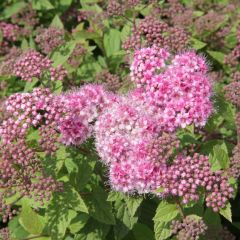
Spiraea japonica Nana
- Flowering time July to October
- Height at maturity 50 cm
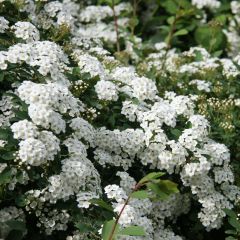
Spiraea arguta
- Flowering time May, June
- Height at maturity 1,50 m
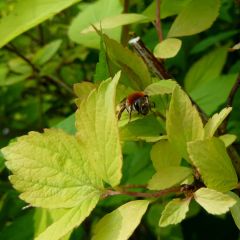
Spiraea (x) vanhouttei Gold Fountain
- Flowering time May to July
- Height at maturity 1,50 m
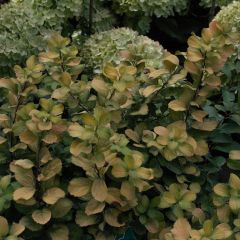
Spiraea betulifolia Tor Gold
- Flowering time June, July
- Height at maturity 80 cm
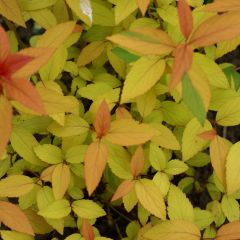
Spiraea japonica Magic Carpet
- Flowering time July to October
- Height at maturity 50 cm
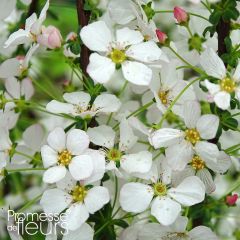
Spiraea thunbergii Fujino Pink
- Flowering time April, May
- Height at maturity 1,50 m
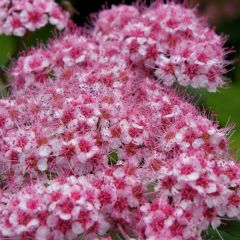
Spiraea japonica Sparkling Champagne
- Flowering time August to October
- Height at maturity 1 m
Discover other Spiraea
Planting the Spirea
Where to Plant
Easy to grow, the Spirea is highly resilient and adapts to most soils and climates.
It can be planted throughout France, except perhaps in Mediterranean climates, which may be too hot and arid in summer. Highly hardy, it can withstand very low temperatures down to -20°C, sometimes even lower depending on growing conditions, ensuring excellent resilience in all regions.
This shrub thrives preferably in full sun, where it flowers best, though it tolerates partial shade, which is preferable for golden-leaved spireas, especially in hot climates.
Undemanding when it comes to soil type, the spirea grows well in ordinary soil, neutral or acidic, rich, fairly moist but without excessive dampness, and well-drained. It also adapts to poorer, drier soils and tolerates some limestone (except for Spiraea x billiardii).
Versatile, the Spirea has a place in every garden. In beds or informal hedges, give the larger varieties enough space to develop fully.
More modest spireas are ideal for small gardens or planted in groups of three as standalone features on a lawn.
Compact species are perfect for rockeries. Dwarf varieties make excellent ground covers on slopes, as well as bed borders and miniature hedges, and adapt very well to container growing on balconies or terraces.
When to Plant
The Spirea, sold bare-root, is best planted in autumn, from September to November, to establish roots before winter, or in spring from February to April. Container-grown plants can be planted year-round, between September and June. Avoid periods of severe frost or extreme heat.
How to Plant a Spirea
In the ground
- Dig a hole 2 to 3 times the size of the pot or a trench for hedge planting
- Add compost and potting soil to the excavated earth
- Plant the spirea at soil level, centred in the hole
- Backfill and firm the soil around the base
- Mulch to keep the roots cool in summer
- Water thoroughly after planting and regularly, when the surface soil dries out, in the first year to ensure establishment
For a spirea hedge
- Space plants 0.60m apart, planted in a staggered pattern
- For ground cover, space plants 0.50m apart
In pots
The substrate should be moist and well-draining. Choose smaller varieties like Spiraea japonica ‘Nana’.
- Plant in a large pot at least 40cm in diameter and depth
- Add a thick layer of drainage (gravel or clay pebbles)
- Plant in a mix of garden soil and shrub compost, enriched with compost
- Mulch the base
- Water generously, never letting the substrate dry out between waterings
- Repot every 2 or 3 years in early spring
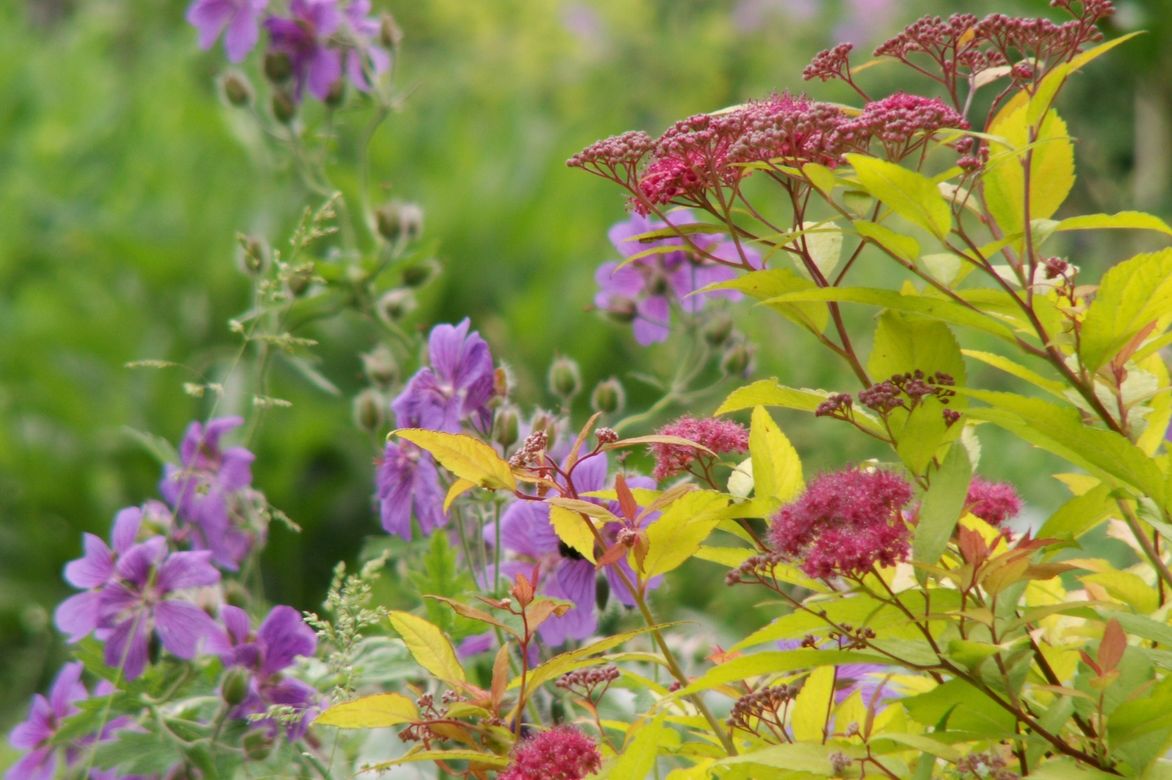
Spiraea japonica ‘Goldflame’ paired with a Geranium magnificum.
Care and Maintenance
Hardy down to -20°C in some cases and drought-resistant once established, the Spirea requires little maintenance.
However, in winter, the young shoots of early-flowering species and cultivars may be damaged by late frosts.
Water every fortnight during the first two years after planting to ensure proper establishment. Thereafter, Spirea will become increasingly drought-tolerant.
Spirea adapts easily to all soil types but prefers moist, not overly dry soils. Mulch around the base of young plants without fail to keep the soil moist in summer.
Every autumn, generous applications of compost or organic fertiliser in spring will improve growth and encourage flowering.
For potted Spireas, keep the rootball slightly moist at all times. Repot every year in early spring. In containers, nutrients deplete quickly: to stimulate flowering, apply 1 to 3 handfuls of organic fertiliser (well-rotted manure, compost, horn meal…) twice yearly, in spring and summer.
When and how to prune spirea?
Spireas don’t necessarily require pruning, however pruning helps achieve beautiful flowering and maintains a dense, compact shape.
Spring-flowering Spireas
Spring-flowering spireas should be pruned in May-June, right after the flowers fade.
- Each year after flowering, cut back the flowered stems, either trimming the tips or cutting the stem at its base. To maintain the plant’s vigour, also remove old wood at the base.
- For an overgrown mature Spirea, cut back stems to 1/3 of their height. Spireas tolerate even severe pruning well, so don’t hesitate to cut back harder if needed.
Summer-flowering Spireas
Summer spireas should be pruned either in late summer or late winter. Remove spent flower heads with shears right after flowering to encourage a slight late summer or early autumn rebloom.
- Every 2 years, cut some dead branches back to ground level to let light through and stimulate new growth.
- For an overgrown or mature Spirea, cut back 1/3 of the stems in late winter. Note: heavy pruning will sacrifice flowers the following year, so only perform this operation occasionally when truly necessary.
Diseases and potential pests
Spirea is a hardy plant that is not susceptible to diseases or serious pests. It may occasionally be attacked by scale insects and aphids, but this is not serious: simply spray with soapy water.
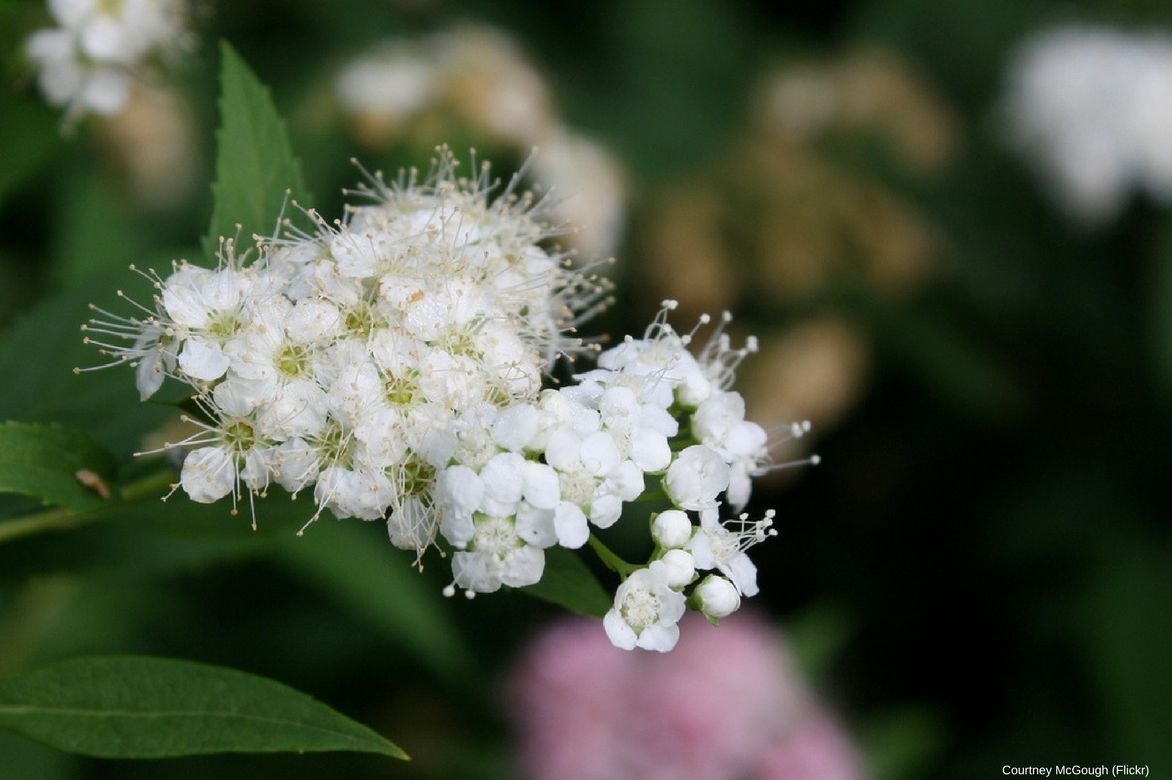
The Spiraea japonica ‘Shirobana’ adorns itself with flowers in shades of pink and white.
Propagation: Taking Cuttings from Spirea
Some species of suckering spireas tend to self-layer naturally: in early spring, take these rooted stems and replant them immediately in the chosen spot.
Alternatively, you can easily propagate Spirea from cuttings of semi-hardwood in June (spring-flowering spireas) or August-September (summer-flowering spireas). This is the simplest and quickest method.
From semi-hardwood cuttings
- Cut just below a node, taking the slender tip of a semi-ripe shoot 10-15 cm long (meaning it’s in transition from softwood to hardwood)
- Score the base of the bark for about 5 cm
- Remove the lower leaves but keep those at the tip
- Plant them in a well-draining mix of sand and special cutting compost
- Keep the growing medium moist until rooting occurs
- Transplant your cuttings into individual pots until the following autumn for their final planting in the garden
Pairing it with the garden
With their abundant, luminous blooms and dense foliage, Spireas are invaluable in both spring displays and summer compositions. They thrive in all natural and cottage-style gardens, creating wonderfully lush scenes brimming with freshness. They are first-rate for landscape designs.
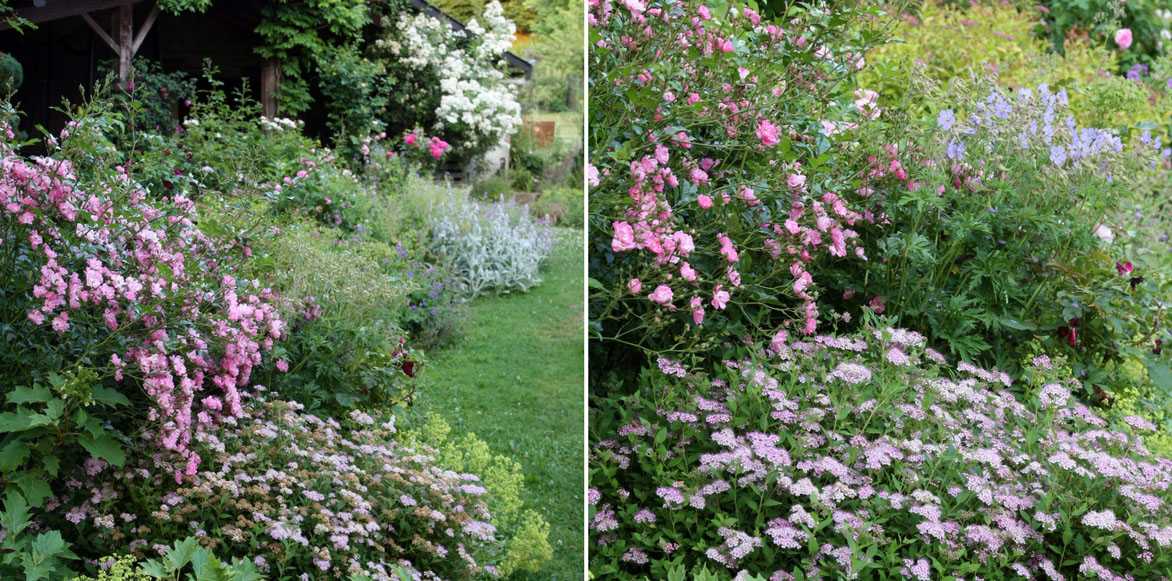
A charming cottage-style pairing: Spiraea japonica ‘Little Princess’, roses including ‘Castor’ in the foreground, Alchemilla mollis, and hardy geraniums.
Summer-flowering spireas pair beautifully with other tall summer-blooming shrubs, whether in a mixed border or for covering large slopes alongside Buddleias, Tamarix tetendra, or large-flowered roses.
Grown in a narrow, flower-filled bed, the arching branches of Spiraea nipponica ‘Snowmound’ contrast strikingly with the billowing masses of Ceanothus arboreus ‘Concha’.
In a low-maintenance shrub border, surround them with plants that precede or follow their magnificent blooms, such as Fremontodendron californicum (April–June), shrubby rockroses (May), Prunus triloba ‘Multiplex’, Prunus × cistena, Prunus tenella, or Ribes sanguineum. They work well in group plantings—mix different spireas together to extend the flowering season and ensure months of blooms!
Spring-flowering species shine alongside mock oranges (Philadelphus coronarius), deutzias, viburnums, and barberries.

An example of a mixed hedge combination: Philadelphus coronarius – Deutzia purpurascens ‘Kalmiiflora’ – Spiraea × vanhouttei – Berberis × ottawensis ‘Superba’ – Viburnum opulus.
White-flowered spireas (Spiraea cinerea ‘Graciosa’, Spiraea nipponica ‘Snowmound’) are staples of white and romantic gardens.
Cultivars of Spiraea japonica with green leaves and pink blooms (‘Double Play Gold’, ‘Anthony Waterer’) pair well with cool-toned flowers like white or mauve roses, a dwarf lilac ‘Miss Kim’, and the silvery foliage of Buddleja ‘Silver Anniversary’.
Golden spireas (Spiraea betulifolia ‘Tor Gold’) complement a cottage hedge alongside Nandina domestica ‘Fire Power’ or the airy Eragrostis spectabilis.
At the front of a small hedge, pair Spiraea japonica ‘Nana’ with other dwarf spireas and a compact weigela.
In a flowering border, combine them with allium bulbs like ‘Globemaster’ or christophii for their spherical blooms, alongside herbaceous perennials such as violet-blue hardy geraniums, campanulas, Penstemon ‘Garnet’, tall late-flowering irises, yarrows, and summer lilies.
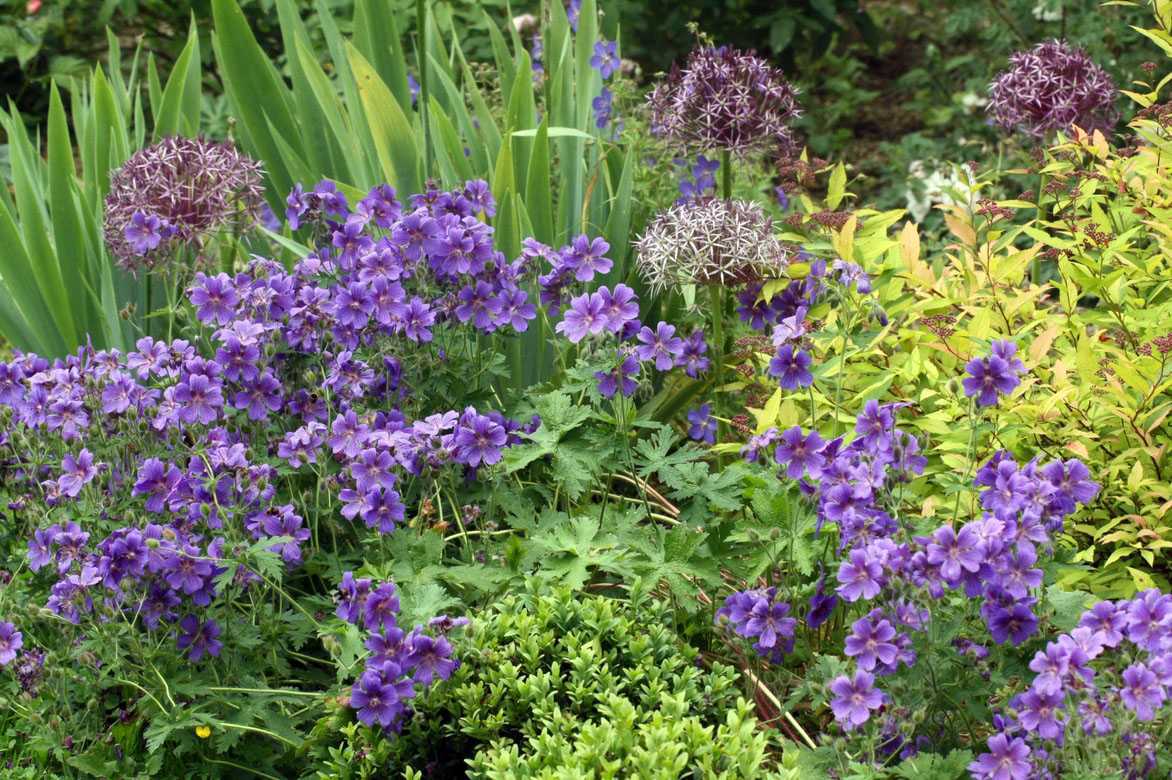
A springtime pairing: foliage of Spiraea japonica ‘Goldflame’ and Iris pallida, Geranium magnificum, and a few Allium cristophii.
At their base, plant Clematis ‘Diamantina’ or Clematis ‘Veronica’s Choice’, which will climb through their foliage and extend the floral display.
Useful resources
- Discover our extensive collection of spireas: you’ll find both the most popular varieties among gardeners and some rare cultivars
- Care guide: How to choose a Spirea?
- Subscribe!
- Contents


































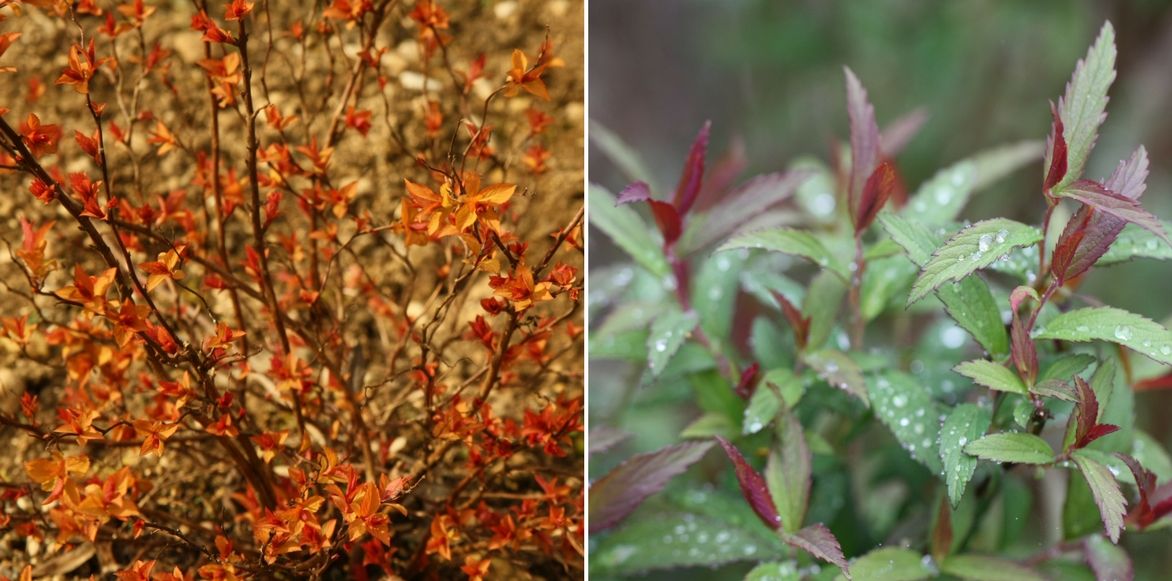
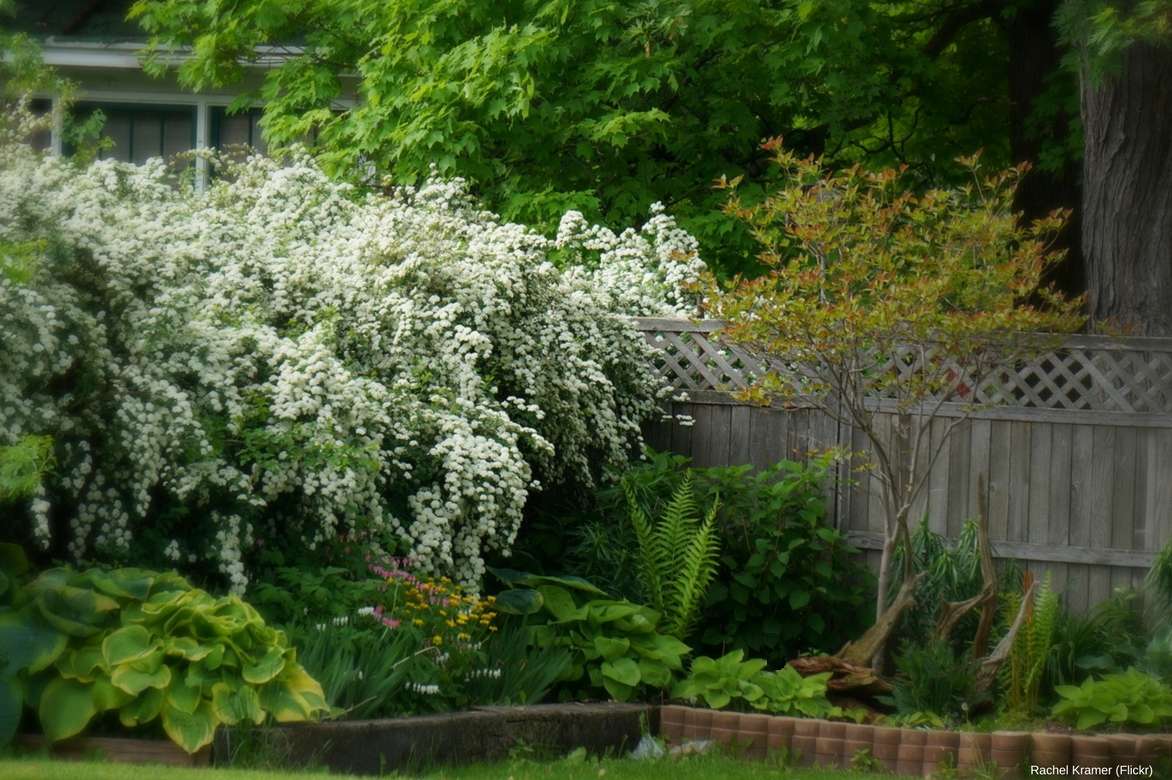



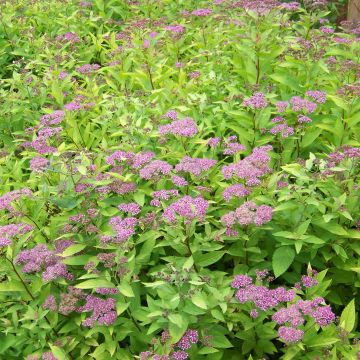

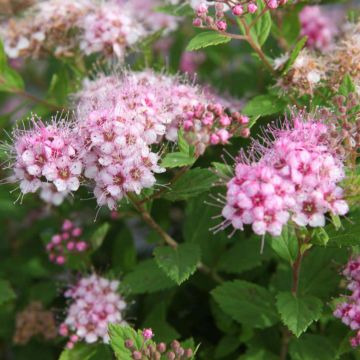

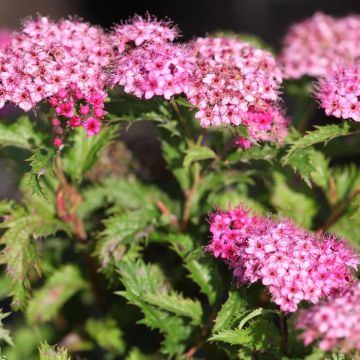



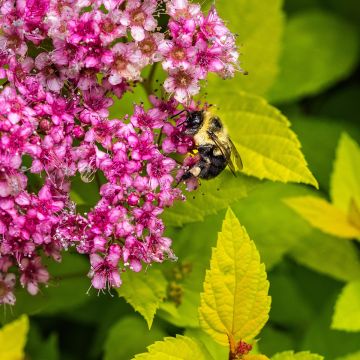
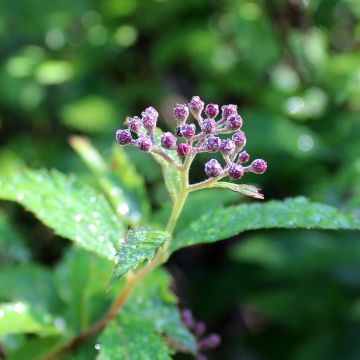
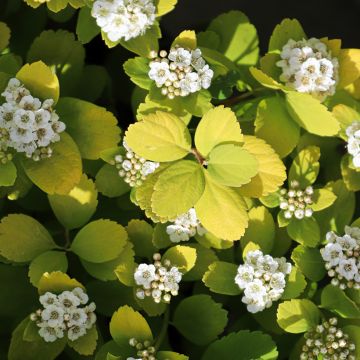

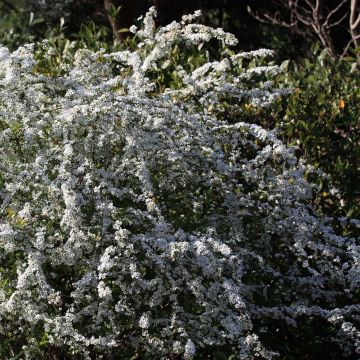
Comments